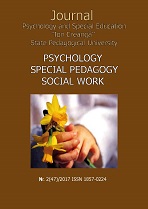De la polimorfism la inexistenţa ortodoxiei. O perspectivă asupra criteriilor de identificare a obiectului reprezentării sociale
From polymorphism to the non-existence of orthodoxy. A perspective on criteria for identifying the object of social representation
Author(s): Mihai ŞleahtiţchiSubject(s): Sociology
Published by: State Pedagogical University „Ion Creanga” from Chisinau
Keywords: social representation; object of social representation; the specificity of the object of social representation;
Summary/Abstract: The process of social representation designates a form of specific knowledge which, "acting simultaneously on the stimulus and the response", links a subject to an object. In its case, we are in fact dealing with a "way of communicating with the outside", with "turning t o the world of phenomena and deeds", with an "articulation of the personality to the social context", with a "mechanism with which theories about the social environment are built", with a "style of conduct towards the outside " or, finally, with a "restoration, a reconstruction of the environment through the perspective of our philosophy of life". By saying "social representation," we actually mean a " modeling of an object into and through behavioral and material linguistic relations". With this object, the type of representation in question is "in a relation of symbolization ( taking its place ) and "interpretation" ( giving it meaning ), being in a variant of expression or in a form of construction of the real ". What prerequisites must there exist for a certain element of the social environment (a person, a situation, an event, a deed, a phenomenon or an idea) to trigger the emergence of a social representation, of a sui generis collective science capable of building "a common vision of the world", a "system of understanding and interpretation of reality", a "strategy of community agreement between individuals or groups"? According to a widespread view, for that to happen, at least five conditions must be met. In brevi , they look like this: (a) the polymorphism [= the object of representation must have several facets, a certain diversity in the social field; the representation of the object at the level of the groups is to obtain particular connotations, specific colors determined by the respective particularities of the population and/or the environment]; (b) way of reference to the social group [= the researcher must capture the link between a social group and the object of representation; "representations are built, developed and worn by social groups"]; (c) identity and cohesion [= the researcher must ensure that the object of representation is in relation with certain social stakes, particularly those related to the identity and cohesion of the group; the members of a group tend to take into consideration the object that makes them see their identity and feel cohesive]; (d) way of reference to the "other social" [= the researcher must establish a close relationship between the object and other social instances in real interaction with the group producing that representation; "if the "other social" to which the group would relate didn‘t exist , the representation would not make sense nor would exist"]; (e) the non - existence of orthodoxy [= the object of representation must not relate to groups subject to regulatory or controlling courts; in the case of social representations, "the processes of organization and structuring occur naturally, without external pressures or interference".
Journal: Psihologie. Pedagogie Specială. Asistență Socială
- Issue Year: 2017
- Issue No: 47(2)
- Page Range: 122-129
- Page Count: 8
- Language: Romanian

